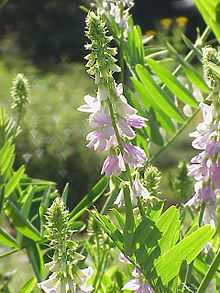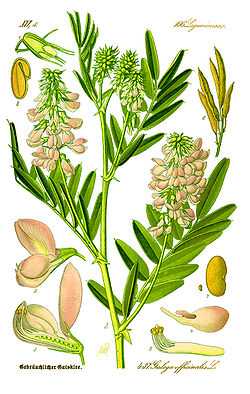Galega officinalis
| Galega officinalis | |
|---|---|
 | |
| Galega officinalis flowers | |
| Scientific classification | |
| Kingdom: | Plantae |
| (unranked): | Angiosperms |
| (unranked): | Eudicots |
| (unranked): | Rosids |
| Order: | Fabales |
| Family: | Fabaceae |
| Subfamily: | Papilionoideae |
| Genus: | Galega |
| Species: | G. officinalis |
| Binomial name | |
| Galega officinalis L. | |
Galega officinalis, commonly known as galega,[1] goat's-rue,[2] French lilac,[3] Italian fitch,[3] or professor-weed,[3] is an herbaceous plant in the Faboideae subfamily. It is native to the Middle East, but it has been naturalized in Europe, western Asia, and western Pakistan. The plant has been extensively cultivated as a forage crop, an ornamental, a bee plant and as green manure.[4] However, the plant has proved too toxic for widespread agricultural use, with the potential to induce tracheal frothing, pulmonary oedema, hydrothorax, hypotension, paralysis and death.[5]
Its name derives from gale (milk) and ega (to bring on), as Galega has been used as a galactogogue in small domestic animals (hence the name "Goat's rue"). Galega bicolor is a synonym. It is a hardy perennial that blooms in the summer months.
G. officinalis is used as a food plant by the larva of Coleophora vicinella, a species of moth.
Distribution
In 1891, G. officinalis was introduced to Cache County, Utah, for use as a forage crop. It escaped cultivation and is now a weed and agricultural pest, though it is still confined to that county. As a result it has been placed on the Federal Noxious Weed List in the United States. It was collected in Colorado, Connecticut and New York prior to the 1930s, and in Maine and Pennsylvania in the 1960s, but no more collections have been made in these areas since and the populations are presumed to have died out. It has also been found in Argentina, Chile, Ecuador, and New Zealand.[4]
Uses
G. officinalis has been known since the Middle Ages for relieving the symptoms of diabetes mellitus. Upon analysis, it turned out to contain compounds related to guanidine, a substance that decreases blood sugar by mechanisms including a decrease in insulin resistance, but were too toxic for human use. Georges Tanret identified an alkaloid from this plant, galegine, that was less toxic, and this was evaluated in unsuccessful clinical trials in patients with diabetes in the 1920s and 1930s.[6][5]
Other related compounds were being investigated clinically at this time, including biguanide derivatives. This work led ultimately to the discovery of metformin (Glucophage), currently used for the management of diabetes[7] and the older agent phenformin.[8] The study of galegine and related molecules in the first half of the 20th century is regarded as an important milestone in the development of oral antidiabetic pharmacotherapy.[9]

Flora von Deutschland, Österreich und der Schweiz 1885
References
- ↑ "USDA GRIN Taxonomy". Retrieved 8 July 2014.
- ↑ "BSBI List 2007" (xls). Botanical Society of Britain and Ireland. Retrieved 2014-10-17.
- ↑ 3.0 3.1 3.2 Shenfield, G (April 2013). "Metformin: Myths, misunderstandings and lessons from history". Australian Prescriber 36 (2): 38–39.
- ↑ 4.0 4.1 Lasseigne, Alex (2003). "Invasive PLants of the Eastern United States: Galega sp.". US Department of Agriculture
- ↑ 5.0 5.1 Bailey CJ, Campbell IW, Chan JCN, Davidson JA, Howlett HCS, Ritz P (eds). 2007. Metformin: the Gold Standard. A Scientific handbook; Chichester: Wiley. Chapter 1: Galegine and anti diabetic plants
- ↑ Witters, L. A. (2001). "The blooming of the French lilac". Journal of Clinical Investigation 108 (8): 1105–7. doi:10.1172/JCI14178. PMC 209536. PMID 11602616.
- ↑ Nathan DM, Buse JB, Davidson MB, Ferrannini E, Holman RR, Sherwin R, Zinman B (2009). "Medical Management of Hyperglycemia in Type 2 Diabetes: A Consensus Algorithm for the Initiation and Adjustment of Therapy: A consensus statement of the American Diabetes Association and the European Association for the Study of Diabetes". Diabetes Care 32 (1): 193–203. doi:10.2337/dc08-9025. PMC 2606813. PMID 18945920.
- ↑ Salpeter S, Greyber E, Pasternak G, Salpeter E. Risk of fatal and nonfatal lactic acidosis with metformin use in type 2 diabetes mellitus. Cochrane Database Syst Rev 2006 Jan 25;(1):CD002967.
- ↑ Bailey CJ, Day, C. (2004). "Metformin: its botanical background". Practical Diabetes Int 21 (3): 115–117. doi:10.1002/pdi.606.
External links
 Media related to Galega officinalis at Wikimedia Commons
Media related to Galega officinalis at Wikimedia Commons- Taxonomy on NCBI (National Library of Medicine).
- Noxious Weed USDA Noxious & Invasive Weeds.